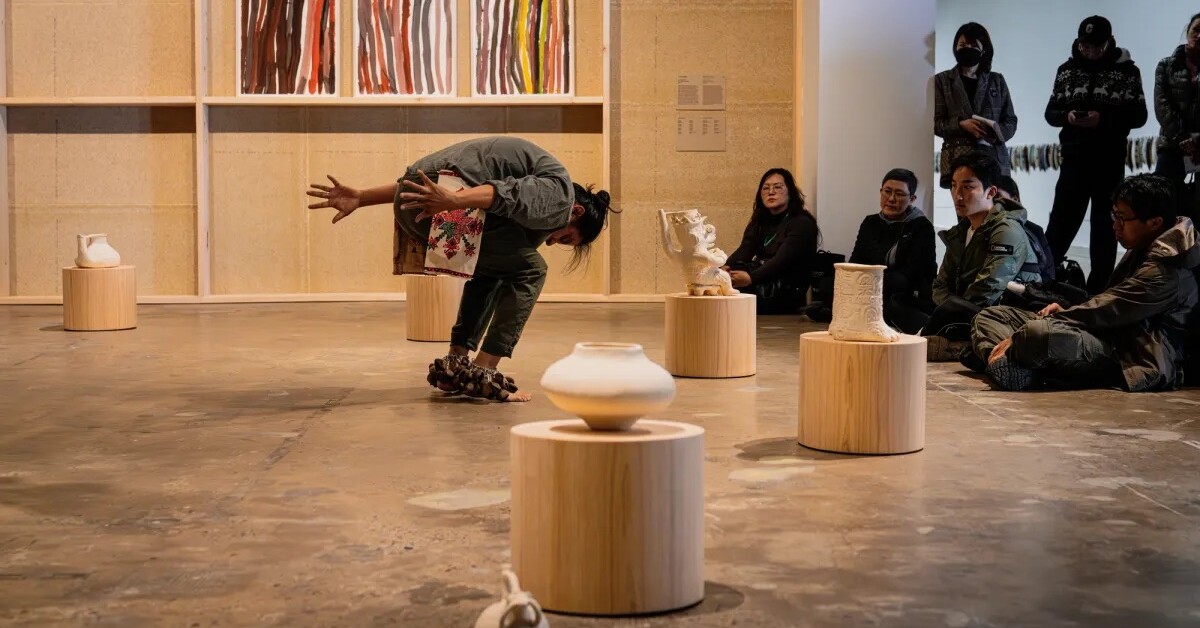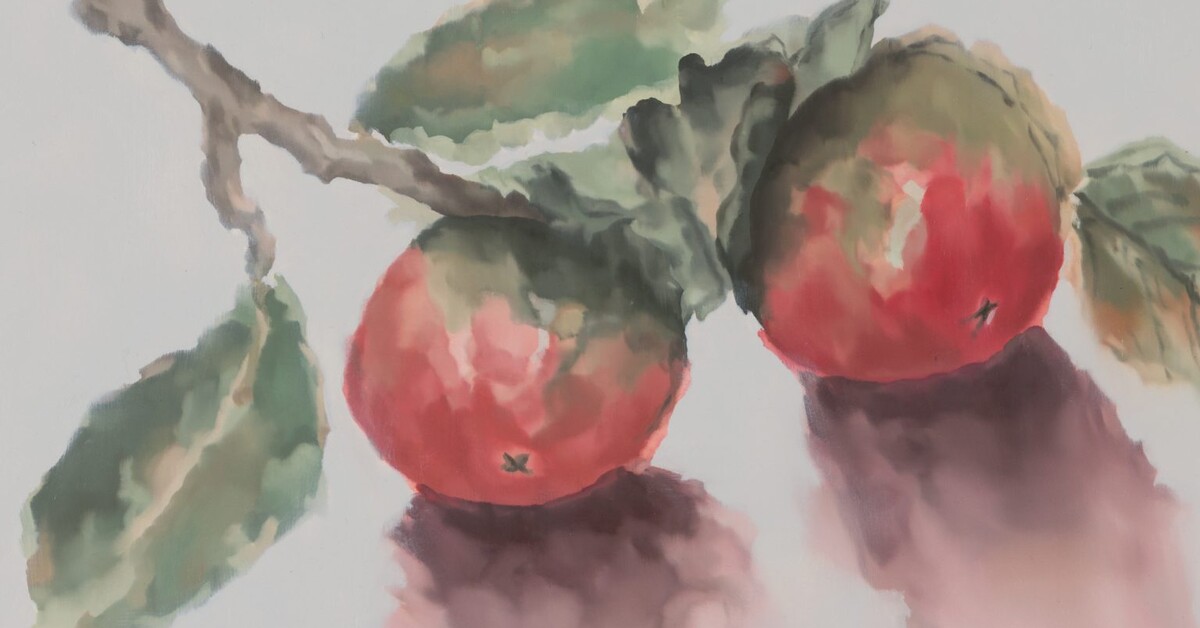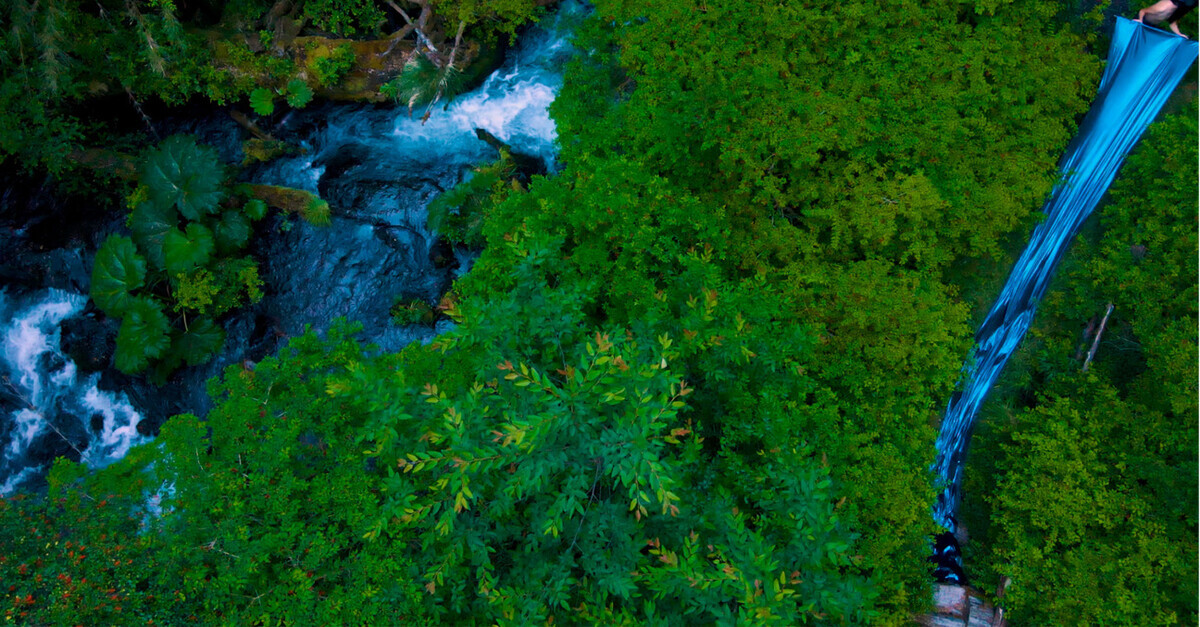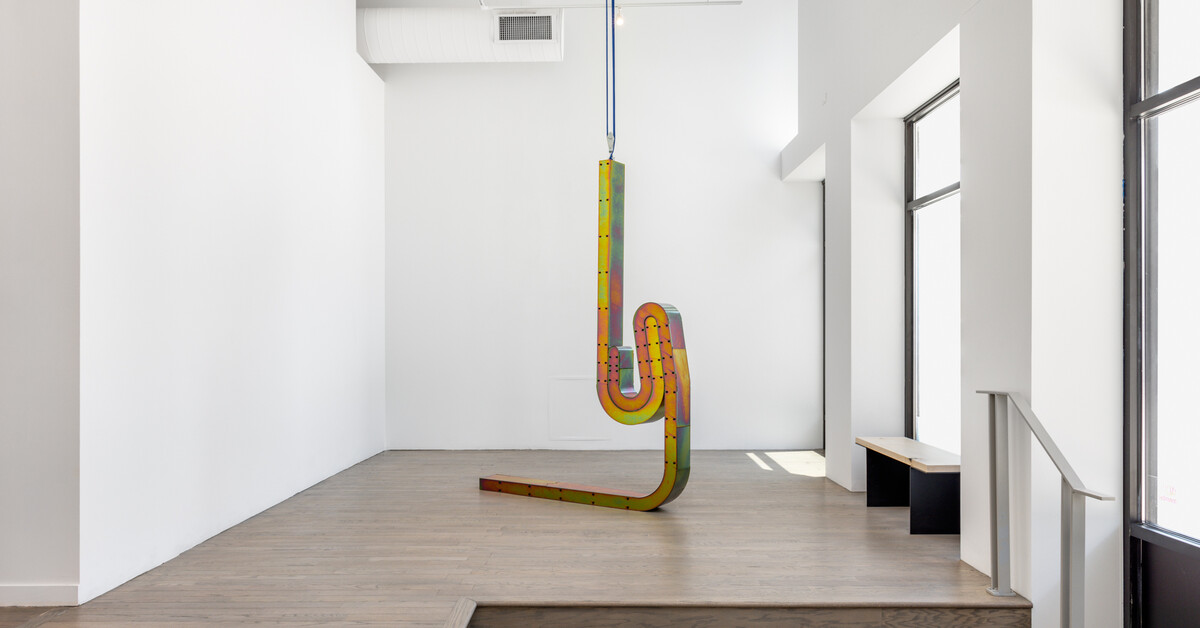Reframing the relationship between humanity and nature
Chicago Reader / Jun 26, 2023 / by Ally Fouts / Go to Original
“The Last of Animal Builders” turns the Farnsworth House into a living, breathing organism.
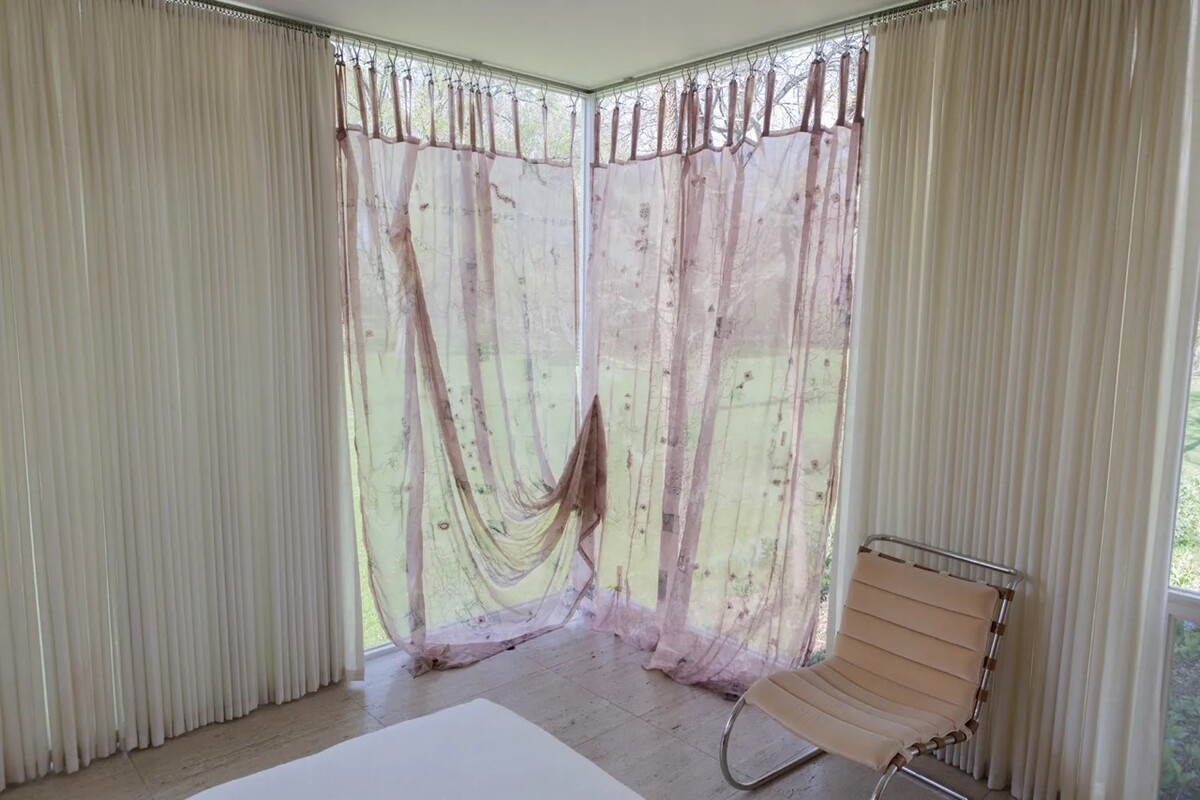
Nestled along the Fox River within the sprawling woods of Plano, Illinois, resides Mies van der Rohe’s coveted Edith Farnsworth House. The house serves as a recognizable and beloved example of midcentury modern architecture, complete with iconic Mies motifs: perimeter floor-to-ceiling windows rather than opaque walls, purposeful and unfussy appliances, minimal use of color, precise division of lines, and inclusion of the celebrated Barcelona chair and daybed. There is seemingly only one way to experience the home: viewers walk around sock-footed and revel in the quiet minimalism.
However, with “The Last of Animal Builders,” curator Alberto Ortega Trejo turns the Farnsworth House into a living, breathing organism. The show features the work of ten artists: ASMA, Faysal Altunbozar, Selva Aparicio, Daniel Baird, Renée Green, Claudia Hart, Ragnar Kjartansson, Thiago Rocha Pitta, Joshi Radin, and Michael Rakowitz. Each artist contributed one piece, which is integrated into the Farnsworth House in both a seamless physical sense and thoughtful metaphorical sense. The resulting exhibition ignites a contemplative treasure hunt of artworks, each offering a moment for deep introspection about humanity’s relationship to the natural world as framed by its architectural footprint.
The exhibition encourages the viewer to reckon with their spatial contribution by means of their physical body, executed ideas, and generated output. The Farnsworth House itself takes shape as a skeletal example of an architectural interrogation in nature. The surrounding woods, at one point lush and untouched, now frame a plot of level earth to support the habitat Mies designed.
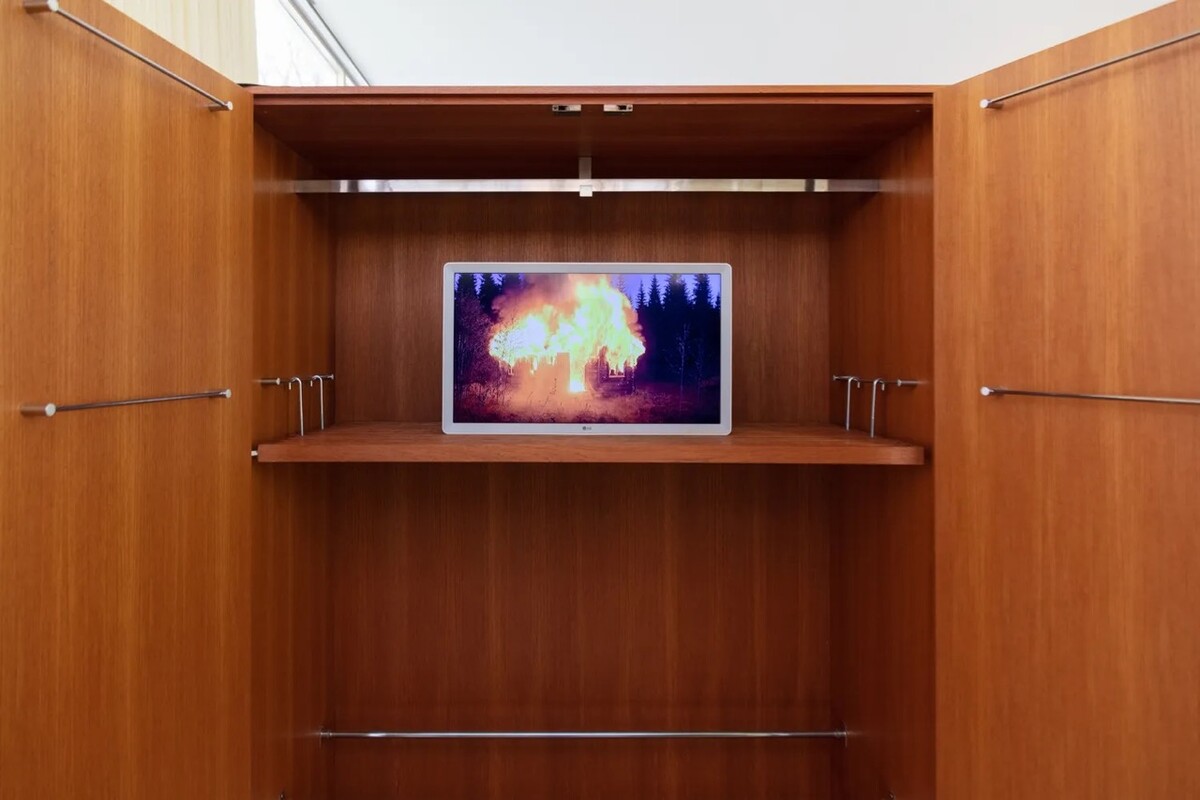
Hanging on a wall in the living room is a framed tree root covered with petite, delicately placed dandelion seeds, titled The Roots (Acto de Fe), by Selva Aparicio. The dainty scale of the individual seeds separated from their final flower form implores the viewer to consider their own microscopic makeup, down to each hair on their arm. The root, sourced from the black sugar maple tree that once stood proudly next to the Farnsworth House but was removed a decade ago, serves as a striking relic of time passed and creation born. The inclusion of The Roots animates the home by replicating how new plants, animals, and humans are the genetic colossal sum of the plants, animals, and humans before them. Bringing a piece of the surrounding environment inside, specifically one that witnessed the genesis and weathered the same conditions as the home, welcomes a poetic and significant appreciation of this cyclical nature of life.
While Aparicio’s piece makes the viewer feel immense, Michael Rakowitz’s paraSITE makes the viewer feel sized down to a grain of rice. Made of plastic bags and polyethylene tubing—the site-specific sculpture connects to the bottom of the house—inflated by steady airflow generated from the home’s heating, ventilation, and air-conditioning system. The home is reiterated as a living organism by way of the placement of paraSITE within the belly of the beast. Bloated and rippled by the wind, the parasite-shaped form survives by sucking nutrients from the home, like a thirsty umbilical cord.
Displayed within the open doors of a cabinet is Burning House by Ragnar Kjartansson. A flat screen plays a looping video of a house perched alone in surrounding woods, the structure set ablaze and engulfed in curls of smoke and charging flames, eerily calming like a digital fireplace. The house in the video mirrors the Farnsworth, both beautiful homes solitary in the woods, but offers a sinister glimpse at a different reality or a potential threat to the home. Burning House exhales life into the Farnsworth by conjuring its death. The connection between humanity and architecture is illustrated by the fragility of both in relation to their environment. The house has fallen victim to flooding in the past, and the National Trust for Historic Preservation is still working to find a solution to this threat with the Flood Mitigation Project. Though uncomfortable to even consider, the fact is that this building is capable of succumbing to unpredictable environmental conditions.
Artist duo ASMA’s piece, Habitational blouse (composition I-IV), hangs in a corner of the building’s window perimeter. Two drapes of semi-translucent fabric are suspended from the window frame like shower curtains and subdue the surrounding greenery with their burnt lavender tint. Like thin stretches of skin, the sheets are penetrable by the beating sun leaking through the window, contorting and wrinkling as they fall to the floor. This piece sits as an open wound exposed to the elements, activated by the breeze of shuffling viewers inside and the changing weather outside.
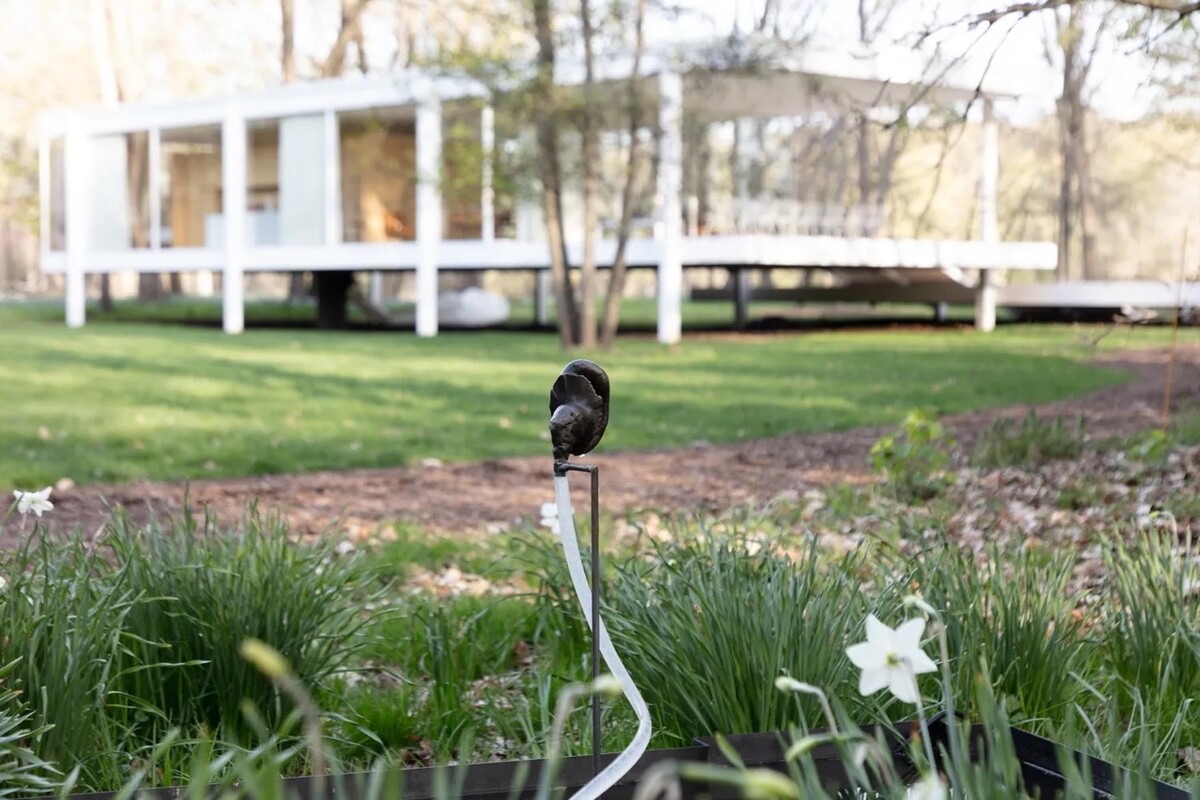
Along the path on the way to the garage is Daniel Baird’s Murmur. A bronze ear floats mischievously, supported by a slim bronze pipe with a clear tube spiraled around it that leads to a square pool of water. The sculptural fountain pulses water through and drips out the earlobe in staccato, rippling the pool beneath in a mesmerizing radial pattern. Located in a quiet neck of the pathway, the ear taunts the viewer to consider the sounds of their surroundings: the subtle dribble of the fountain, the distant birds calling, rustling trees, and voices of other patrons. Meditative and repetitive, Murmur becomes a grounding pulse for the house, reverberating steadily in the viewer’s ears for the sprawling stretch of the exhibition.
The Farnsworth House was built to be a purposefully skeletal structure, which lets the surrounding environment be less of a backdrop and more of an amenity to the home. In “The Last of Animal Builders,” Ortega Trejo fills this skeleton with invigorating organs by carefully including artists whose work supports a sustained and generative exploration of the cyclical relationship between humanity and nature through the lens of architecture. The thoughtful consideration of each artistic addition leads to a deeply contemplative experience of grappling with what it means to be alive.

Artist duo ASMA’s Habitational blouse (composition I-IV) hangs in a corner of the building, subduing the surrounding greenery with a burnt lavender tint.; Credit: Joshi Radin
Nestled along the Fox River within the sprawling woods of Plano, Illinois, resides Mies van der Rohe’s coveted Edith Farnsworth House. The house serves as a recognizable and beloved example of midcentury modern architecture, complete with iconic Mies motifs: perimeter floor-to-ceiling windows rather than opaque walls, purposeful and unfussy appliances, minimal use of color, precise division of lines, and inclusion of the celebrated Barcelona chair and daybed. There is seemingly only one way to experience the home: viewers walk around sock-footed and revel in the quiet minimalism.
However, with “The Last of Animal Builders,” curator Alberto Ortega Trejo turns the Farnsworth House into a living, breathing organism. The show features the work of ten artists: ASMA, Faysal Altunbozar, Selva Aparicio, Daniel Baird, Renée Green, Claudia Hart, Ragnar Kjartansson, Thiago Rocha Pitta, Joshi Radin, and Michael Rakowitz. Each artist contributed one piece, which is integrated into the Farnsworth House in both a seamless physical sense and thoughtful metaphorical sense. The resulting exhibition ignites a contemplative treasure hunt of artworks, each offering a moment for deep introspection about humanity’s relationship to the natural world as framed by its architectural footprint.
The exhibition encourages the viewer to reckon with their spatial contribution by means of their physical body, executed ideas, and generated output. The Farnsworth House itself takes shape as a skeletal example of an architectural interrogation in nature. The surrounding woods, at one point lush and untouched, now frame a plot of level earth to support the habitat Mies designed.

In Burning House by Ragnar Kjartansson, a flat screen plays a looping video of a burning house alone in surrounding woods, a mirror of the Farnsworth.; Credit: Joshi Radin
Hanging on a wall in the living room is a framed tree root covered with petite, delicately placed dandelion seeds, titled The Roots (Acto de Fe), by Selva Aparicio. The dainty scale of the individual seeds separated from their final flower form implores the viewer to consider their own microscopic makeup, down to each hair on their arm. The root, sourced from the black sugar maple tree that once stood proudly next to the Farnsworth House but was removed a decade ago, serves as a striking relic of time passed and creation born. The inclusion of The Roots animates the home by replicating how new plants, animals, and humans are the genetic colossal sum of the plants, animals, and humans before them. Bringing a piece of the surrounding environment inside, specifically one that witnessed the genesis and weathered the same conditions as the home, welcomes a poetic and significant appreciation of this cyclical nature of life.
While Aparicio’s piece makes the viewer feel immense, Michael Rakowitz’s paraSITE makes the viewer feel sized down to a grain of rice. Made of plastic bags and polyethylene tubing—the site-specific sculpture connects to the bottom of the house—inflated by steady airflow generated from the home’s heating, ventilation, and air-conditioning system. The home is reiterated as a living organism by way of the placement of paraSITE within the belly of the beast. Bloated and rippled by the wind, the parasite-shaped form survives by sucking nutrients from the home, like a thirsty umbilical cord.
Displayed within the open doors of a cabinet is Burning House by Ragnar Kjartansson. A flat screen plays a looping video of a house perched alone in surrounding woods, the structure set ablaze and engulfed in curls of smoke and charging flames, eerily calming like a digital fireplace. The house in the video mirrors the Farnsworth, both beautiful homes solitary in the woods, but offers a sinister glimpse at a different reality or a potential threat to the home. Burning House exhales life into the Farnsworth by conjuring its death. The connection between humanity and architecture is illustrated by the fragility of both in relation to their environment. The house has fallen victim to flooding in the past, and the National Trust for Historic Preservation is still working to find a solution to this threat with the Flood Mitigation Project. Though uncomfortable to even consider, the fact is that this building is capable of succumbing to unpredictable environmental conditions.
Artist duo ASMA’s piece, Habitational blouse (composition I-IV), hangs in a corner of the building’s window perimeter. Two drapes of semi-translucent fabric are suspended from the window frame like shower curtains and subdue the surrounding greenery with their burnt lavender tint. Like thin stretches of skin, the sheets are penetrable by the beating sun leaking through the window, contorting and wrinkling as they fall to the floor. This piece sits as an open wound exposed to the elements, activated by the breeze of shuffling viewers inside and the changing weather outside.

Daniel Baird’s Murmur is a sculptural fountain pulses water through a bronze ear.; Credit: Joshi Radin
Along the path on the way to the garage is Daniel Baird’s Murmur. A bronze ear floats mischievously, supported by a slim bronze pipe with a clear tube spiraled around it that leads to a square pool of water. The sculptural fountain pulses water through and drips out the earlobe in staccato, rippling the pool beneath in a mesmerizing radial pattern. Located in a quiet neck of the pathway, the ear taunts the viewer to consider the sounds of their surroundings: the subtle dribble of the fountain, the distant birds calling, rustling trees, and voices of other patrons. Meditative and repetitive, Murmur becomes a grounding pulse for the house, reverberating steadily in the viewer’s ears for the sprawling stretch of the exhibition.
The Farnsworth House was built to be a purposefully skeletal structure, which lets the surrounding environment be less of a backdrop and more of an amenity to the home. In “The Last of Animal Builders,” Ortega Trejo fills this skeleton with invigorating organs by carefully including artists whose work supports a sustained and generative exploration of the cyclical relationship between humanity and nature through the lens of architecture. The thoughtful consideration of each artistic addition leads to a deeply contemplative experience of grappling with what it means to be alive.

